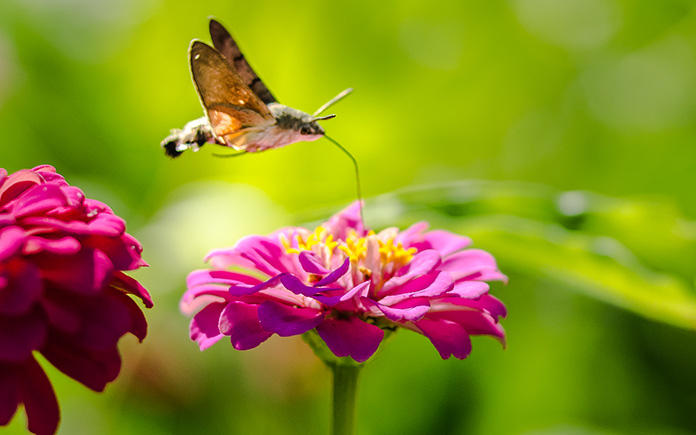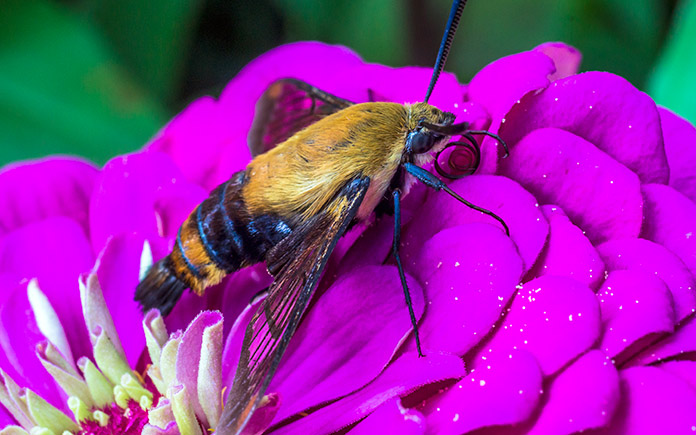
Picture this: You’re enjoying an afternoon on your patio or porch and, suddenly, hear the telltale buzzing of a hummingbird. But upon closer inspection, you realize it’s not a bird at all — it’s a hummingbird moth.
Meet the Hummingbird Moth
People initially mistake this bug — which the British call the bee hawk-moth, from the Hemaris genus of Sphinx moths — for the hummingbird. That’s because it acts very much like the bird it mimics.
This moth shimmers, sips, hovers and darts and — yes — even hums! Males have a flared tail, just like a hummingbird. And their wings beat faster than the eye can see.
In fact, wing beating is where these moths outshine their namesake. Hummingbirds hover at 50 beats per second, but the hummingbird hawkmoth almost appears motionless, flying at 85 beats per second.
Of course, there are some differences that set these critters apart.
While hummingbird moths don’t have a long beak, they do have a straw-like, long proboscis that unfurls like a garden hose to draw nectar from garden flowers.
And, of course, the hummingbird is a bird, and the hummingbird moth is a moth!
Species of Hummingbird Moths
North America has four species of these moths. Among them, you’ll most likely encounter the Snowberry Clearwing hummingbird moth, also known as the Hemaris diffinis, and the Hummingbird Clearwing, aka Hemaris thysbe.
Adults aren’t that different from other moths and butterflies; they feast on various flowers’ nectar. Larvae especially enjoy honeysuckle, cherries and plums.
The Sphinx moth family is a robust group of colorful (and huge!) moths. They grow up to 2 inches long and you might mistake them for hummingbirds, with their green and red markings and tufts of hairs that look a lot like feathers.
Unlike many other species of moths that mostly fly at dusk, hummingbird moths such as white-lined sphinx moths, are often seen feeding during the day, and they’re drawn to the same types of flowers as hummingbirds.



Mating and Reproduction
When the moth lays eggs, you’ll notice green eggs underneath leaves. Sphinx moths begin their larvae cycle as hornworms, which are large caterpillars with a hornlike part at their rear end.
The bright-green hornworm hatches from eggs attached to plants like honeysuckle, hawthorns, viburnum, and cherry. Then they munch around and make their way down toward the earth, where they form brown cocoons hidden underground and in piles of leaf litter.
Adult moths emerge in the spring and summer. In colder areas, there is only one generation per year, but warmer areas can support multiple life cycles in a year.
Hornworms are generally harmless to garden plants, unlike their cousins — tomato and tobacco hornworms — that can wreak havoc on crops.
The adult moths are beneficial insects. They make excellent pollinators, working during the day and night to improve your garden!
Naturally, many gardeners want to attract hummingbird moths, but they’re just not sure how to do it.
The simple way? Just plant fragrant flowers that this moth can’t wait to dip its proboscis into! Bee balm, moonflower, morning glories, jasmine and honeysuckle are some options.
It’s satisfying when birds and butterflies are attracted to a garden’s food plants and feeders, and now you can add one more friendly helper: the hummingbird moth!



